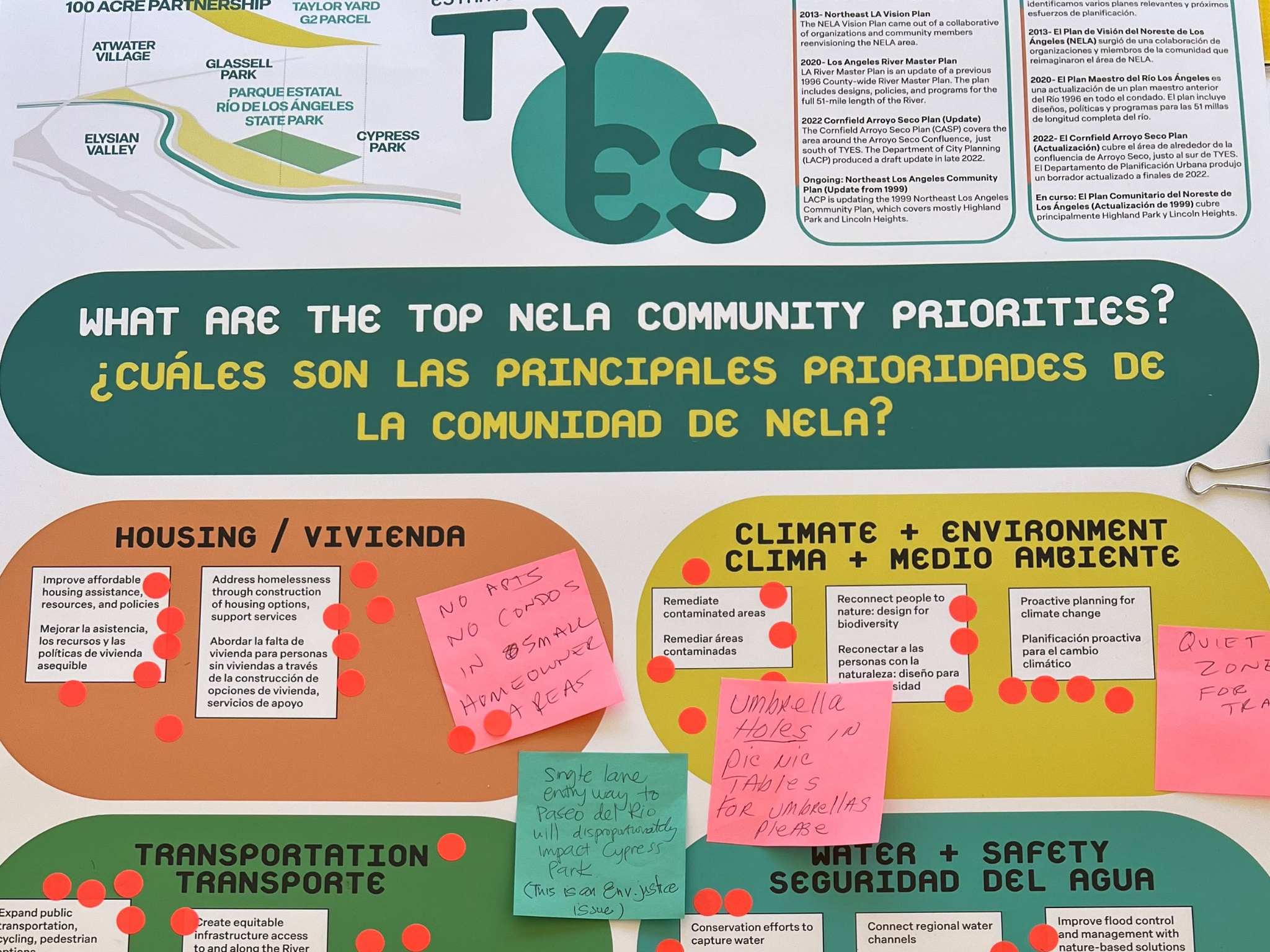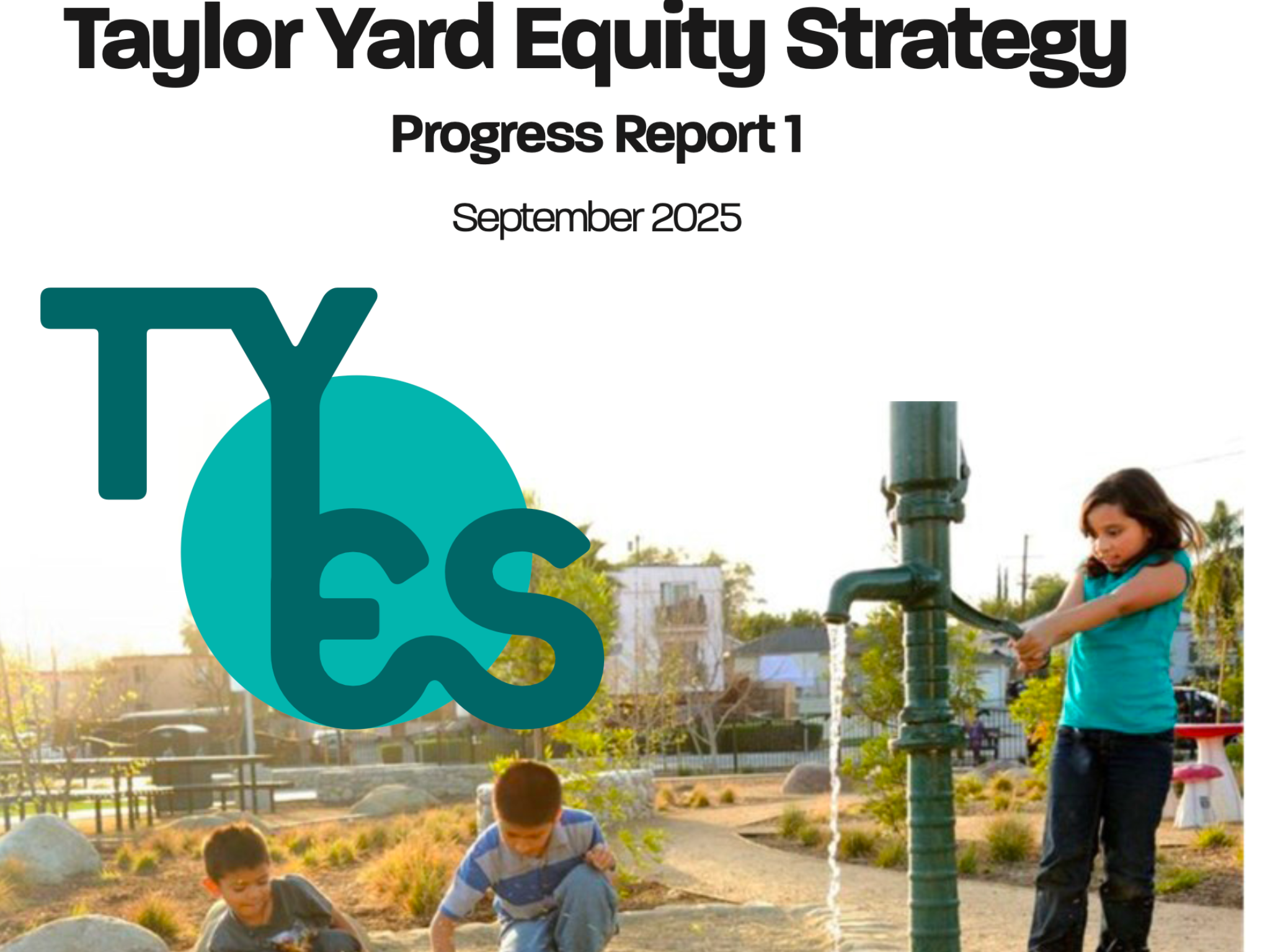Community TYES Progress Report: Building Equity at Taylor Yard

The Community Taylor Yard Equity Strategy, or TYES, is a community-driven effort to ensure that as new parks and green space are created along the Los Angeles River, the neighbors who live nearby can remain rooted to thrive in place.
Launched in 2021 by the City of Los Angeles and the 100 Acre Partnership, a collaboration of the City, California State Parks, and the Mountains Recreation and Conservation Authority, TYES began in direct response to community concerns. Residents welcomed the long-awaited restoration of the Taylor Yard site, but they also worried: after enduring the contamination from the railyard, would this major public investment in restored riverfront habitats and parkland benefit the local communities, or accelerate gentrification and displacement?
The City partnered with the Los Angeles Regional Open Space and Affordable Housing (LA ROSAH) Collaborative, the Resources Legacy Fund, and UCLA to lead the work. Together, they committed to creating a new model where equity is not an afterthought, but built into the planning and implementation of a 100-acre park. The purpose of TYES is simple but urgent: to link environmental restoration with housing stability, workforce opportunities, and cultural equity, so longtime residents benefit from public investments instead of being pushed out.
This newly released TYES Progress Report 1 is the first milestone in this journey. It reflects extensive community listening and feedback gathered from local residents, organizations, and stakeholders. The report summarizes the groundwork laid so far and presents twenty opportunities for action to help protect communities and shape an equitable future at Taylor Yard.
What the progress report covers
The first TYES Progress Report pulls together lessons from research, community listening, and strategy sessions. The report does three main things:
1. Introduces the project geography and 100 Acre Partnership projects – including the Bowtie Parcel, Taylor Yard G2, and Río de Los Angeles State Park.
2. Summarizes community conversations and concerns – especially fears of displacement, rising rents, and the need for meaningful job opportunities.
3. Proposes twenty opportunities for equity action – a roadmap for policies, programs, and collaborations that could protect and strengthen local communities as Taylor Yard is transformed.

Twenty Opportunities for Equity
The heart of the Progress Report is a set of 20 strategic opportunities for action. These opportunities are not one-size-fits-all solutions, but areas where TYES partners can focus their efforts and invite collaboration. They span issues such as:
Housing stability: tenant protections, preserving affordable housing, and exploring community ownership models.
Workforce development: creating training pipelines and prioritizing local hiring in park construction and maintenance.
Small business support: ensuring neighborhood-serving businesses can withstand rising costs and compete in a changing economy.
Cultural preservation: uplifting local stories, languages, and traditions through design and programming.
Youth investment: creating leadership opportunities and safe, accessible spaces for recreation and growth.
The twenty opportunities are framed as building blocks—ideas that can be tested, refined, and scaled with input from residents, partners, and agencies.
Two Priority Areas
While the opportunities cover a wide range of issues, two areas emerged as top priorities based on community input and research:
1. Housing Stability
• Residents fear that new parks will drive up rents and attract speculative investment.
• The report highlights measures to protect tenants, prevent evictions, preserve existing affordable housing, and explore tools like land trusts or cooperative housing models.
• It also acknowledges the need to connect this work to broader citywide efforts on homelessness prevention and housing affordability.
2. Workforce Development
• In addition to creating open green space and parkland, the 100-acre projects at Taylor Yard should/can/will build pathways to good jobs.
• The report calls for intentional pipelines so that local residents—especially youth, immigrants, and underemployed workers—can access new employment opportunities.
• This includes construction jobs during the build-out, as well as long-term “green jobs” in park maintenance, environmental restoration, and climate resilience work.
By centering these two areas, TYES aims to address the most pressing risks of displacement while also unlocking opportunities for wealth-building and stability.
Community at the Center
Another key theme of the report is process. TYES is designed to be ongoing and iterative. The Progress Report acknowledges the realities of “planning fatigue” in NELA—residents have been asked for their input many times over the years, often without seeing results. This time, the commitment is to act on what residents have said, and to keep communities directly involved in shaping decisions.
The report itself was informed by listening tours, workshops, and interviews with residents, community-based organizations, and experts. That process surfaced both concerns and creative ideas, many of which now shape the opportunities outlined.
Looking Ahead
The Progress Report is not a final plan but a milestone in a long journey. It sets the stage for deeper work in the next phase of TYES: prioritizing the most impactful strategies, identifying partners to carry them forward, and securing the resources to make them real.
As the 100 Acre Park moves toward construction and opening, the stakes remain high. Without equity strategies, parks can accelerate gentrification. With equity strategies, they can become engines of shared health, wealth, and resilience. TYES is working to prove that the latter is possible.
Read the Full Report
This summary highlights the key elements of Progress Report 1: how TYES began, why it matters, and where it is headed. The full report offers a detailed examination of the research, findings, and twenty opportunities for action. We invite you to download it, read more, and join the conversation about how to make Taylor Yard a model for equitable community development.
Download the full report in English here.
For the Spanish translation, see here.
Live in NELA?
Get involved with the
Community Taylor Yard Equity Strategy (TYES).
Share your voice.
Stay informed.